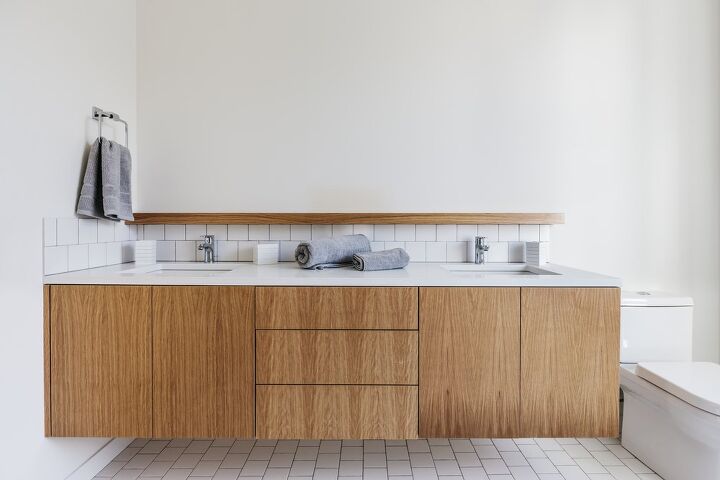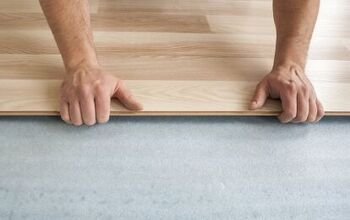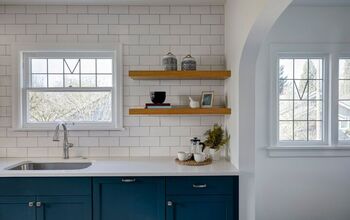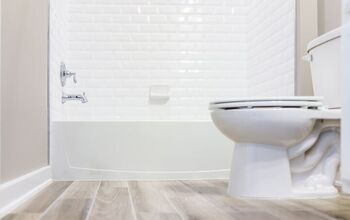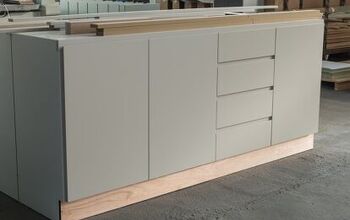What Are Floating Cabinets? (Find Out Now!)

When it comes to modern interior design, giving your house a space-age look is in. In fact, it seems like designers are trying to push the boundaries as to what can and cannot be done in a home. One of the newer trends to hit the modern design scene is the floating cabinet. But, what exactly is this?
Floating cabinets are small cabinets that are affixed directly to the wall, off the floor. This gives them the appearance of floating in the air. These are often used for displaying knickknacks rather than actually storing heavy objects.
If you want to have a statement cabinet in your home, getting a floating cabinet is a good idea. However, there’s a lot to know about these before you buy them.
Do You Need to Hire Cabinet Installers?
Get free, zero-commitment quotes from pro contractors near you.

What Are Floating Cabinets?
Floating cabinets are exactly what they sound like: cabinets that don’t touch the ground. They have to be mounted to walls, often on studs using special arm branches to support them. They’re stylish, chic, and pretty popular for people who want a unique twist on a classic item.
Honestly, it is best to show what I mean by offering an illustration to what they look like. As you can see in the photo above, it does have a definite floating feeling. However, it’s not floating. It’s bolted to the wall behind it, giving it some stability.
How Much Weight Can Floating Cabinets Hold?
Honestly, most floating cabinets have a maximum weight load that rests under 150 pounds, and that’s if they are mounted on the wall studs with specialty equipment. In some cases, you might even need masonry installation to get that high weight load.
It’s worth noting that sheetrock walls do not hold much weight on their own. If you have a simple “mini” floating cabinet, you might be able to hold up to 20 pounds with it if you put it on sheetrock alone. So, it’s best to keep those for light items like fluffy towels, knickknacks, and faux flowers.
Note: Always check the maximum load of your floating cabinet before you buy them.
Are Floating Cabinets Easy To Install?
They are a lot easier to install than you think, that’s for sure. Floating cabinets basically rest on a set of arms that are installed directly onto the studs of the wall. From there, the cabinets are placed on top of the arms and secured by some screws. Easy, peasy.
How Popular Are Floating Cabinets?
These cabinets are popular among people who love modern furniture, but that’s about it. They’re fairly niche and it’s going to be a long time before these become mainstream…if they ever do. Most of the time, this is considered to be a specialty item due to the fact that they can’t hold as much weight as a standard cabinet.
The only time when floating cabinets are common is in the bathroom, in the form of a medicine cabinet. Almost everyone has one there.
Why Are Floating Cabinets Uncommon?
Floating cabinets are still actually quite rare, and there are several reasons why this is the case. While they can be very stylish, they have a lot of drawbacks that make it hard for people to want to keep them around. These are the biggest things to be worried about:
- You usually can’t hold much with them. Yes, some can hold as much as 150 pounds, but those are in the minority. You have to remember that those payloads require a lot of sturdiness and special installations in order for them to function to that capacity.
- They can damage walls if they are not installed properly. Bad installs and too much weight? That’s a recipe for a destroyed wall.
- These cabinets do not go with all types of interior design concepts. There, I said it. It’s true. They are pretty terrible if you are trying to get a Victorian home. They also are a bit strange for homes that aren’t modern.
- If you have an earthquake, it’s game over. There’s no way to mince words. When it comes to areas like San Francisco or Tokyo, earthquakes are a common issue. Unfortunately, these cabinets can’t be jostled around too much. In some cases, floating cabinets can damage a home’s frame during an earthquake.
- Landlords hate them. I wish there was any other way to say it, but landlords do not allow cabinets that “float.” They’re a risk to structure and some also worry about injury liability. Besides, it’s not like you can take them with you when you move.
Do You Need to Hire Cabinet Installers?
Get free, zero-commitment quotes from pro contractors near you.

Related Questions
How much weight does a typical floating shelf hold?
Floating shelves are not meant to be as sturdy as a full floating cabinet. This means that they will not always do well with the load that they offer. Most floating shelves are meant to carry lighter weights, often in the ballpark between 15 to 20 pounds. In some cases, they can carry as much as 50 pounds. Either way, it’s best to assume they don’t carry much.
Where are floating cabinets the most common?Believe it or not, there is one room where floating cabinets are fairly common: the bathroom. You might have a medicine cabinet that is tucked behind a mirror. That is actually considered to be a floating cabinet by most people. With that said, that’s a fairly specific niche that tends to be of service for one particular arena. It’s not the norm in all rooms!
Why do floating shelves and cabinets sag?This is one issue that you should always pay attention to: materials. Over time, the materials of floating shelves and cabinets won’t be able to hold their weight as well. This will cause your shelves to dip and warp, especially when exposed to moisture.
If you want to avoid this issue, the best thing that you can do is to choose shelving made from metal. Metal won’t sag, nor does it really weaken over time. As a result, it’s the most reliable material you can get for floating cabinets. It’s cool like that.

Ossiana Tepfenhart is an expert writer, focusing on interior design and general home tips. Writing is her life, and it's what she does best. Her interests include art and real estate investments.
More by Ossiana Tepfenhart



